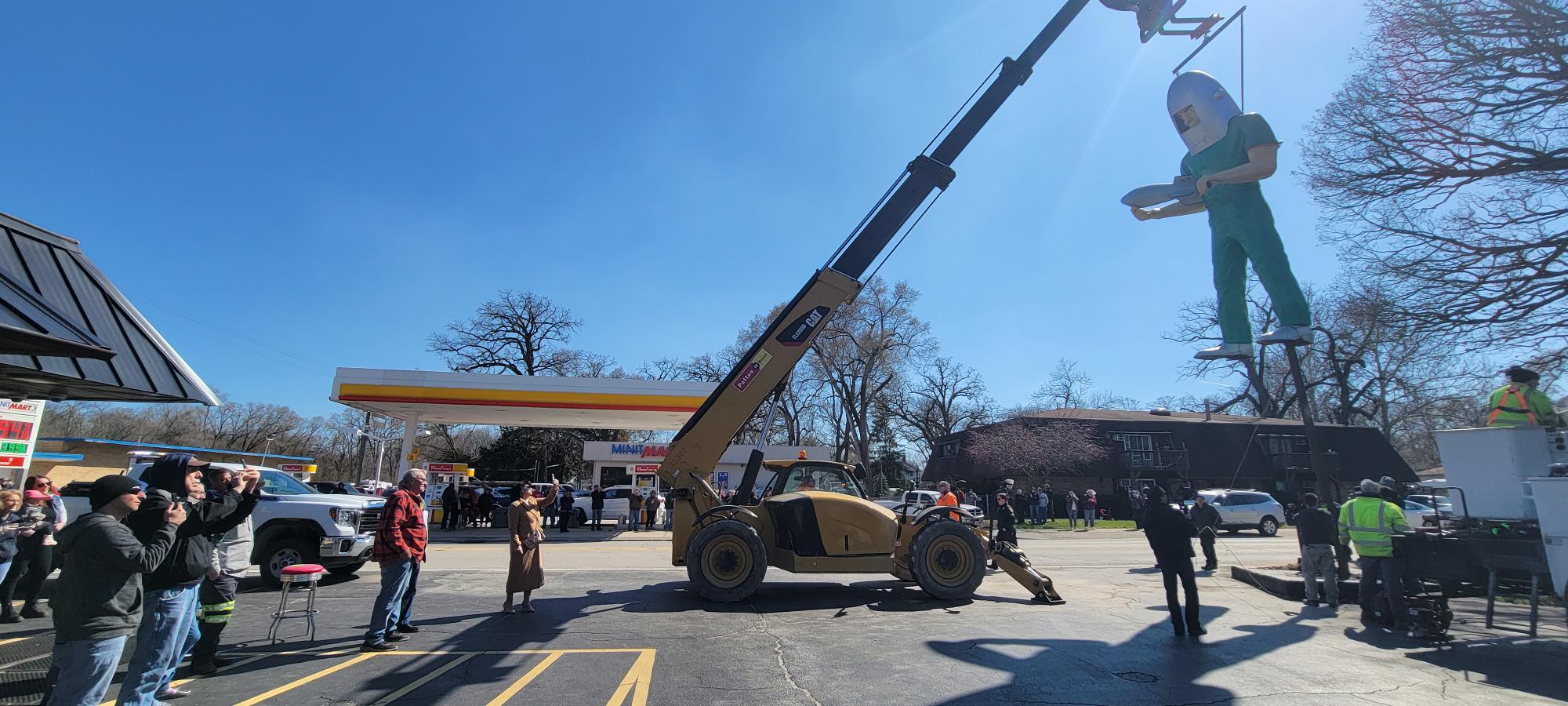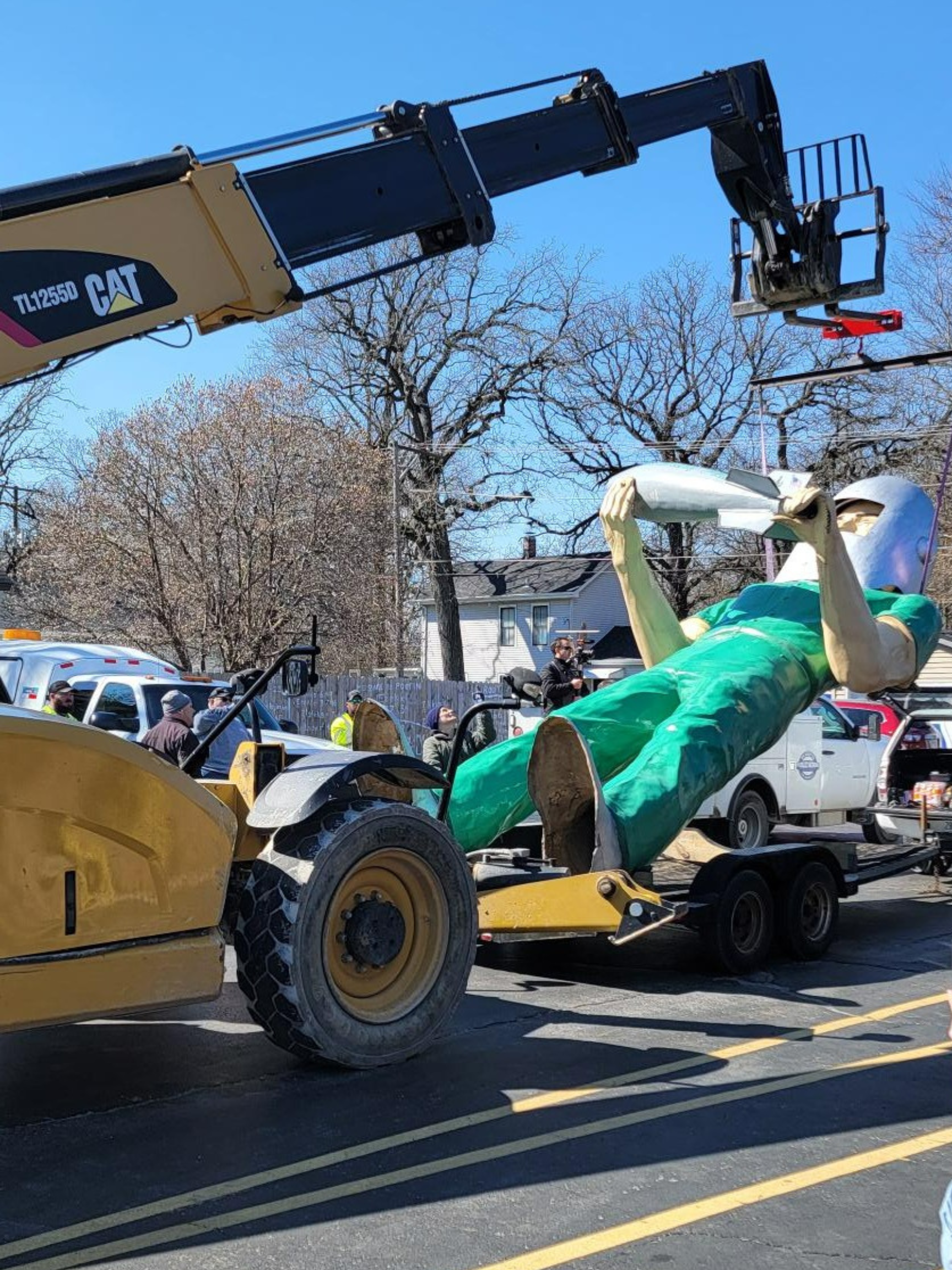A group of history buffs quietly scored a giant win on March 21.
Since the mid-1960s, the Gemini Giant, a fiberglass statue 20 feet tall of an astronaut holding a rocket, had stood outside a restaurant in Wilmington, Ill. But in 2022 the owner closed down the restaurant, called the Launching Pad, and this year put the restaurant’s fixtures and the Gemini Giant up for auction.
On March 18, three days before the online auction by Grafe Auctions, the Minnesota firm’s website said the highest bid recorded so far for the Gemini Giant was $60,000. At that time, Ryan Jandura, a retired firefighter who was trying to save the Gemini Giant for Wilmington, had raised about $27,000 on the GoFundMe page he had set up with a goal of raising $100,000.
It looked like the Gemini Giant might be leaving Wilmington — maybe even leaving Illinois.
Then on auction day, Grafe announced in the morning that the winning bid came in at $275,000. That afternoon, a truck with a specially designed rack on its trailer pulled up in front of the Launching Pad to take the Gemini Giant away. Wilmington’s mayor announced the giant was only leaving to undergo restoration and will come back to a site about a mile from the Launching Pad.
As it turned out, there had been a dark horse in the race the whole time.
A coalition led by the Joliet Area Historical Museum had been ready to sweep in with a hefty bid using tourism funds from the state. With the 18% buyers premium the auction house charges, the museum will spend $324,500 funded by the Illinois Department of Commerce and Economic Opportunity
In the last weeks before the auction “we were intentionally quiet,” Greg Peerbolte, the museum’s executive director, told WBEZ’s Reset. “We knew it was a live auction and we didn’t want to stifle efforts (like Jandura’s) to keep the giant in Wilmington. We were observing, and we were hopeful that we would pursue it.”

They didn't keep the secret from Jandura. The day before the auction, the museum-led group let him know that it was involved. He was relieved, he said after the auction was over, because "it was obvious we didn't have enough to buy it, and it might get bought by somebody who took it out of Wilmington."
At least two other bidders stayed active until the price reached $200,000, but their identities haven't been disclosed. One of them bid $250,000 but didn't counter the museum's $275,000.
Bret Waters, who managed the auction for Grafe, said there were more than 300 registered bidders, but he couldn’t disclose how many bids there were or what amounts anyone bid.
Also part of the team was Michael Younkin, a leader in the effort to save old roadside giants. He brought with him the people behind the American Giants Museum, an old gas station in Atlanta, Ill., that is all about these kooky old giants.
Once the group had word from Grafe that they had prevailed in the online auction, the preservationists arrived at the Launching Pad with a crane, a police escort and a truck onto which Younkin had built a rack for carrying it.
Peerbolte and others wouldn’t confirm why they had to rush to get the statue out of there. But there were reports in the local Patch outlet that the restaurant’s owner had been breaking the establishment’s windows and piling debris in the parking lot.
The crew cut the 500-pound Gemini Giant off at the feet. A crane lifted him into the air and laid him down on the truck, which drove away.
He’ll be back. The Gemini Giant went down to Atlanta, Ill., where he’s going to get restored before returning to Wilmington. The town’s mayor, Ben Dietz, announced the same day the Gemini Giant left town that it will come back to a new home in Wilmington’s South Island Park, where the town will use the statue as the anchor of its salute to Route 66.
Route 66, the legendary highway that started in Chicago at Jackson Boulevard and Michigan Avenue and ran almost 2,450 miles to Los Angeles, opened in November 1926.
The Gemini Giant will be reinstalled ahead of the 2026 centennial, Peerbolte said.
The statue is part of a mid-20th-century genre of giant human sculptures used as advertising. Some people call them “Muffler Men” because many of them held mufflers in their hands, and others just call them giants. They can be seen in all sorts of places and media, including in the 1992 movie Wayne’s World, where the characters sing Queen’s Bohemian Rhapsody in their car and drive past a Native American giant that still stands atop a building at 63rd Street and Pulaski Road.

In the opening credits for Amy Poehler’s sitcom Parks and Recreation, there are two giants.
From 1962 to 1974, International Fiberglass in Venice, Calif., made these giants for businesses throughout the U.S.
In August, CBS News reported that probably a few hundred still stand, and many of them have been the subject of rescue efforts like what happened with the Gemini Giant.
CBS’s Conor Knighton said in the segment that if they’re in good condition they sell “for tens of thousands of dollars,” which is much, much less than the Gemini Giant went for.
In Atlanta, the Gemini Giant is in good company. Near the museum is a fiberglass giant holding a hotdog. A fixture for decades at a Cicero restaurant, he was moved down to Atlanta after Bunyon’s closed in the early 2000s. The hotdog guy and another giant, a silly-faced statue the original maker called “Half-Wits,” are sentinels for the American Giants Museum, whose founder, Joel Baker, has been collecting and restoring giants since the early 2010s and has a YouTube channel about his adventures.
Dennis Rodkin is the residential real estate reporter for Crain’s Chicago Business and Reset’s “What’s That Building?” contributor. Follow him @Dennis_Rodkin.



